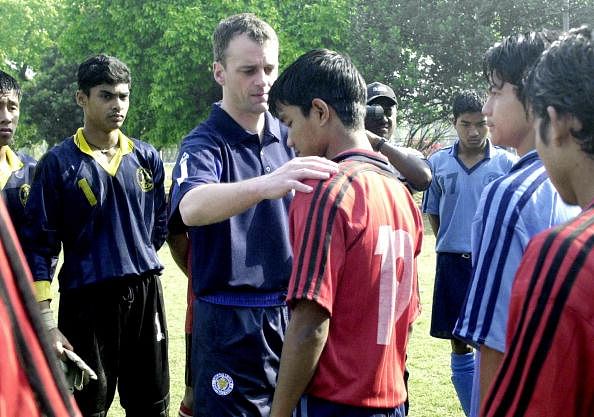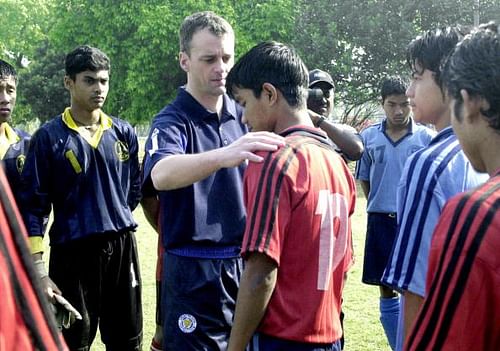
The umbilical cord that entwined East Bengal to Leicester City

Leicester City’s academy coach John Rudkin (C) pats the shoulder of an under-17 Indian football team player during a coaching session in Kolkata, 11 March 2004. Rudkin’s spell as India u-17 coach was an immediate outcome of the English club’s three-year agreement with the AIFF and East Bengal.
Kingfisher East Bengal are renowned and respected throughout India, with a proud history that stretches back almost one hundred years, and yet ten years ago I’d never heard of them.
I first came to India on January 26 2003, staying five days in the country. At the time I was firmly focused on China where we were working with the Shide Group and their two clubs, Dalian Shide and Sichuan Dahe, and top Italian clubs AS Roma, Juventus and AC Milan.
India wasn’t on the radar and I knew absolutely nothing about Indian football.
Suman Kalyan Dutta, a football fanatic and sports business consultant from Kolkata, sent me an avalanche of emails selling me the idea that India – not China – was the next big thing in football. In the end I decided I’d come and take a look.
From the moment I arrived at the airport to the moment I left, it was evident to me that Kolkata at least was passionate about football.
I arrived at the Taj hotel to find a TV crew waiting in the lobby, and from that point forward, there was a constant stream of interviews and appointments, of visits to see stadiums, and meetings with an assortment of interested parties. As my flight home took to the skies I looked down at Kolkata which had already begun to weave its unique hypnotic spell which I’ve never been able to break.
Around one year later, I arrived in Kolkata with Paul Mace, COO of Premier League side Leicester City, to formalize a partnership between them, the AIFF and East Bengal.
For City, the partnership was in part an attempt to engage with the huge local ethnic Indian/Asian community in Leicester, but it was also to connect with an important market that had a shared heritage with the UK.
Before choosing East Bengal they had done a lot of research regarding local opinions and preferences, and I’d also prepared a detailed report outlining the history and tradition of the big Kolkata clubs. Being one of the forerunners of Indian football, East Bengal had a distinct advantage.
Leicester City were the first Premier League club to recognize the potential of India and to engage with football here. Although the partnership agreement was intended to last three years, it faded away ahead of time.
City were relegated and suffered the adverse financial impact that comes with that. They were hit by a substantial fall in income and they had to cut back. At the same time, Kingfisher failed to throw their full weight behind the venture. Despite this, the partnership made history and achieved some notable successes.
East Bengal became the first Indian club to play against an English Premier League side when they took part in the four-team Pepsi Max Challenge at the Walkers Stadium in the summer of 2004, together with Maritimo of Portugal and Spanish side Real Mallorca.
In the opening game City and East Bengal played out an absorbing game. The English team was technically superior, fitter and more experienced and yet the pride of India were desperately unlucky not to win.
They were denied a clear cut penalty and had a highly dubious penalty awarded against them, and that in the end was the difference in a 1-0 defeat. The courage, commitment and tenacity of the Indian players, with Bhaichung Bhutia always a threat, won them genuine respect.
In the crowd watching were the India Under-16 squad, who were being coached by John Rudkin, City’s Academy Director, prior to the AFC Championships.
Rudkin had earlier travelled to India to help select and coach the squad in Kolkata. The Indian boys responded to a first game hammering by City’s Academy team by drawing 0-0 with Stoke City before claiming a 1-0 win over a highly rated Birmingham City side. One of the Indian players even appeared as a second half substitute for Leicester City in a friendly against Liverpool FC’s Academy, and didn’t look out of place.
A measure of the importance of East Bengal’s visit, and of its symbolic importance in the relationship between Britain and India was the reception given to the club at the House of Commons, hosted by Deputy Prime Minister John Prescott.
Given the right levels of investment from all three sides the partnership could have achieved so much more. Nevertheless, what we were able to do, the history that was created, and the way in which it raised awareness of football in India to a wider audience are landmarks that will stand the test of time.